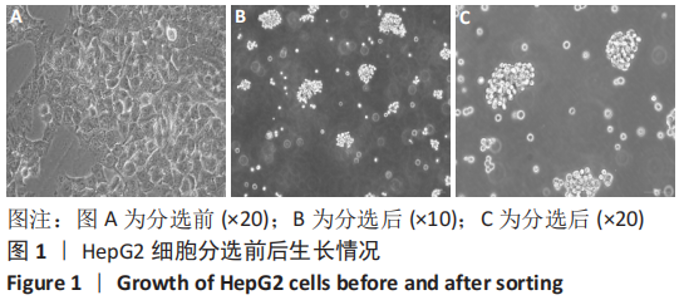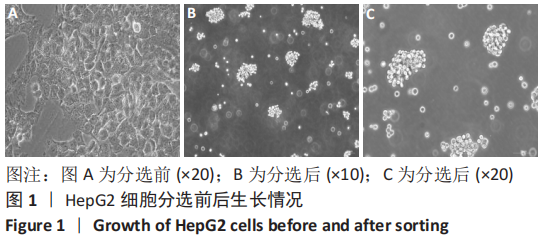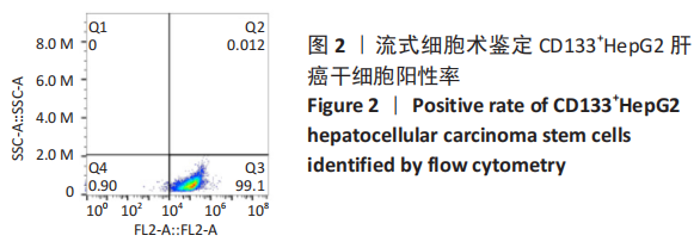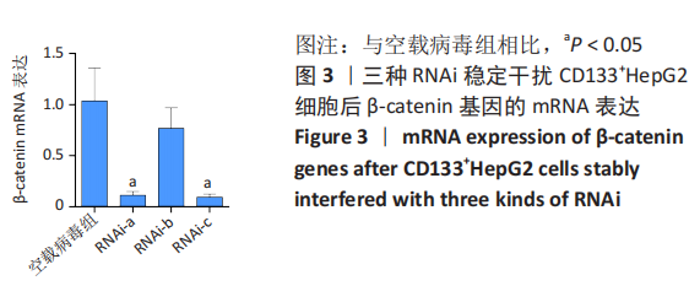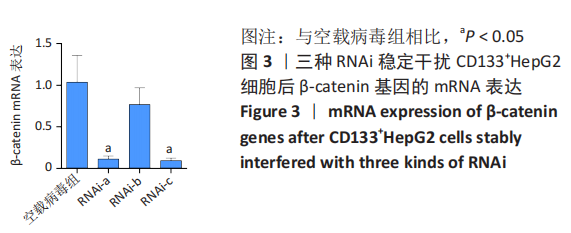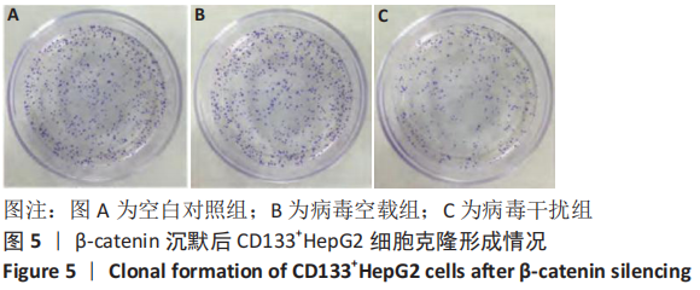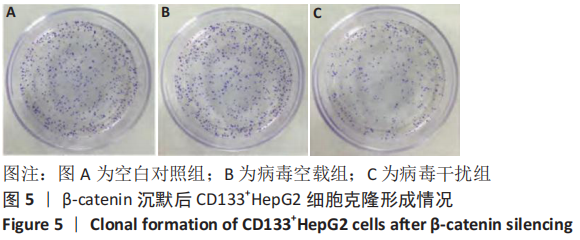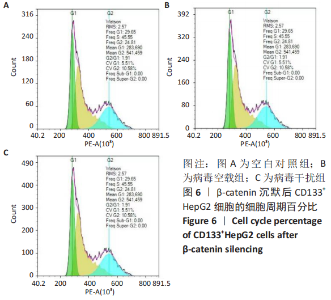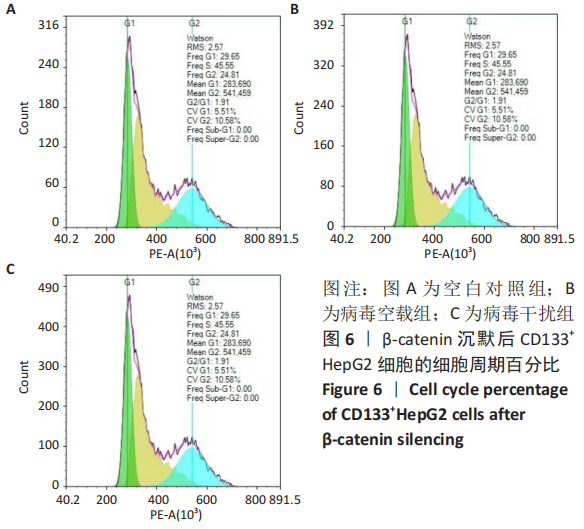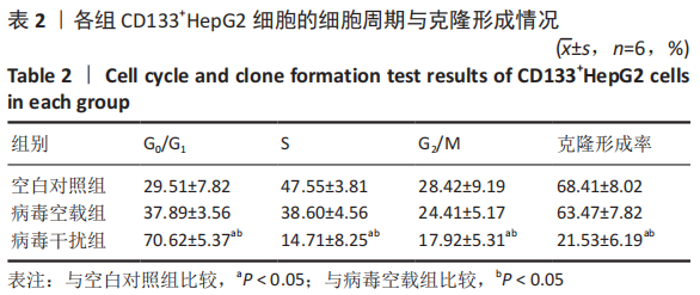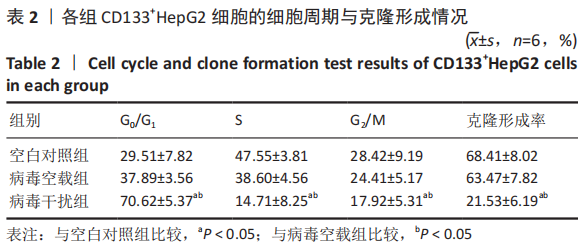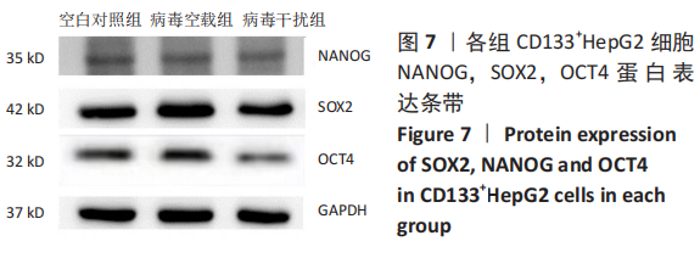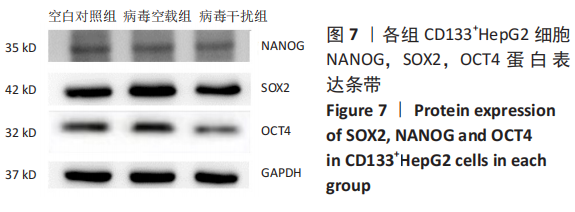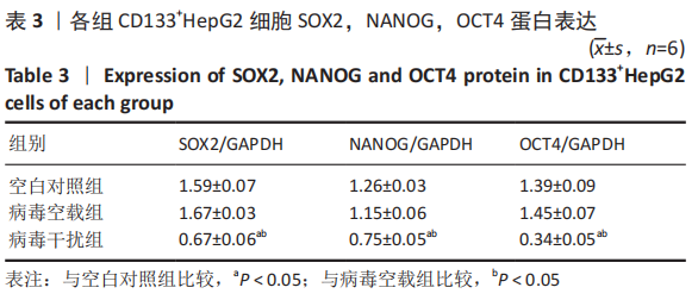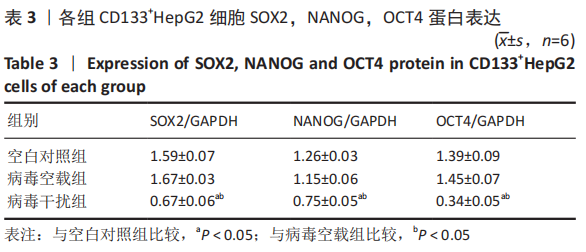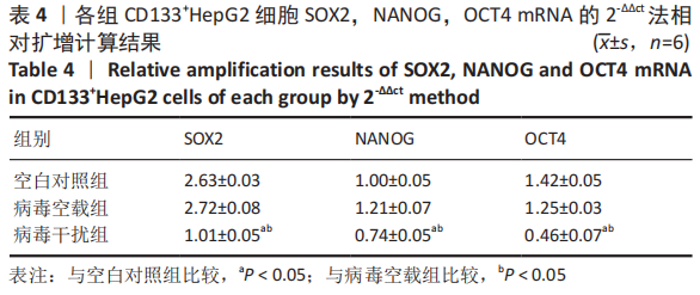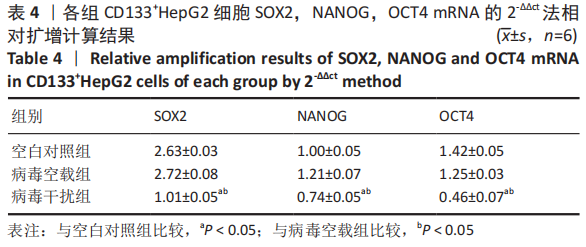Chinese Journal of Tissue Engineering Research ›› 2023, Vol. 27 ›› Issue (15): 2297-2303.doi: 10.12307/2023.364
Effects of beta-catenin gene silencing on stemness transcription factors in hepatocellular carcinoma stem cells
Sun Hua1, 2, Qin Yanchun2, Rong Zhen1, Li Zulong2, Jiang Ruiyuan2, Zhong Xiaoting2, Mo Chunmei1
- 1Bao’an Authentic TCM Therapy Hospital, Shenzhen 518101, Guangdong Province, China; 2Guangxi University of Traditional Chinese Medicine, Nanning 530200, Guangxi Zhuang Autonomous Region, China
-
Received:2022-03-25Accepted:2022-06-22Online:2023-05-28Published:2022-10-17 -
Contact:Mo Chunmei, Chief physician, Professor, Bao’an Authentic TCM Therapy Hospital, Shenzhen 518101, Guangdong Province, China -
About author:Sun Hua, Master candidate, Bao’an Authentic TCM Therapy Hospital, Shenzhen 518101, Guangdong Province, China; Guangxi University of Traditional Chinese Medicine, Nanning 530200, Guangxi Zhuang Autonomous Region, China -
Supported by:National Major Project on Infectious Disease Prevention and Control, No. 2018ZX10303502-001; 2018ZX10303502-002 (to RZ, MCM); National Natural Science Foundation of China, No. 81760850 (to MCM)
CLC Number:
Cite this article
Sun Hua, Qin Yanchun, Rong Zhen, Li Zulong, Jiang Ruiyuan, Zhong Xiaoting, Mo Chunmei. Effects of beta-catenin gene silencing on stemness transcription factors in hepatocellular carcinoma stem cells[J]. Chinese Journal of Tissue Engineering Research, 2023, 27(15): 2297-2303.
share this article
Add to citation manager EndNote|Reference Manager|ProCite|BibTeX|RefWorks
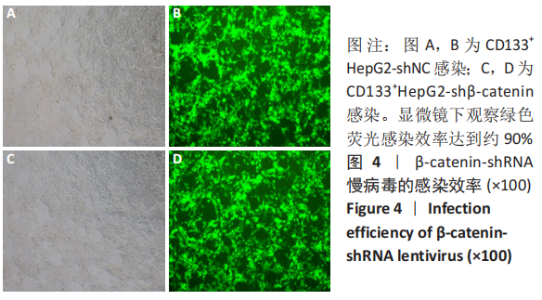
2.3 β-catenin-shRNA 慢病毒的沉默效果和感染效率 慢病毒或慢病毒空载体转染CD133+HepG2细胞后,应用RT-PCR方法检测3种RNAi稳定干扰β-catenin的情况,结果显示RNAi-a以及RNAi-c的封闭效果达到90%,见图3,后续实验采用干扰能力最佳的RNAi-c干扰序列。病毒稳定感染获得β-catenin基因沉默的CD133+HepG2细胞(病毒干扰组)和病毒对照CD133+HepG2-shNC细胞(病毒空载组),转染72 h后通过倒置荧光显微镜观察细胞中病毒所带荧光的发光比例,见图4。此次实验显示β-catenin-shRNA 慢病毒的感染效率约90%,病毒转染效果良好,进行扩增、提纯后用于后续实验。"
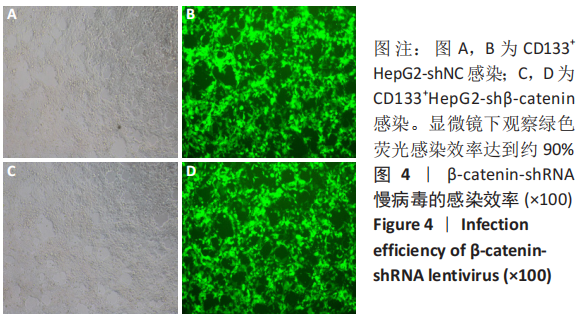
| [1] SUNG H, FERLAY J, SIEGEL RL, et al. Global Cancer Statistics 2020: GLOBOCAN Estimates of Incidence and Mortality Worldwide for 36 Cancers in 185 Countries. CA Cancer J Clin. 2021;71(3):209-249. [2] CAO W, CHEN HD, YU YW, et al. Changing profiles of cancer burden worldwide and in China: a secondary analysis of the global cancer statistics 2020. Chin Med J (Engl). 2021;134(7):783-791. [3] VOGEL A, SABOROWSKI A. Current strategies for the treatment of intermediate and advanced hepatocellular carcinoma. Cancer Treat Rev. 2020;82:101946. [4] CHEN Z, XIE H, HU M, et al. Recent progress in treatment of hepatocellular carcinoma. Am J Cancer Res. 2020;10(9):2993-3036. [5] CHANG JC. Cancer stem cells: Role in tumor growth, recurrence, metastasis, and treatment resistance. Medicine (Baltimore). 2016; 95(1 Suppl 1):S20-S25. [6] SCHULTE LA, LÓPEZ-GIL JC, SAINZ B JR, et al. The Cancer Stem Cell in Hepatocellular Carcinoma. Cancers (Basel). 2020;12(3):684. [7] YOVCHEV MI, GROZDANOV PN, JOSEPH B, et al. Novel hepatic progenitor cell surface markers in the adult rat liver. Hepatology. 2007; 45(1):139-149. [8] OWENS KM, KULAWIEC M, DESOUKI MM, et al. Impaired OXPHOS complex III in breast cancer. PLoS One. 2011;6(8):e23846. [9] BONNET D, DICK JE. Human acute myeloid leukemia is organized as a hierarchy that originates from a primitive hematopoietic cell. Nat Med. 1997;3(7):730-737. [10] PANDIT H, LI Y, LI X, et al. Enrichment of cancer stem cells via β-catenin contributing to the tumorigenesis of hepatocellular carcinoma. BMC Cancer. 2018;18(1):783. [11] KIM E, LISBY A, MA C, et al. Promotion of growth factor signaling as a critical function of β-catenin during HCC progression. Nat Commun. 2019;10(1):1909. [12] 杨丽兰.Sema4C在宫颈癌中调节上皮间质转化及其机制研究[D].南昌:南昌大学,2020. [13] 李淑娜,宋娜娜.生物信息学分析肝癌干细胞中致瘤基因表达的差异[J].中国组织工程研究,2016,20(23):3407-3412. [14] WANG W, SMITS R, HAO H, et al. Wnt/β-Catenin Signaling in Liver Cancers. Cancers (Basel). 2019;11(7):926. [15] LI P, CAO Y, LI Y, et al. Expression of Wnt-5a and β-catenin in primary hepatocellular carcinoma. Int J Clin Exp Pathol. 2014;7(6):3190-3195. [16] KIM H, WU J, YE S, et al. Modulation of β-catenin function maintains mouse epiblast stem cell and human embryonic stem cell self-renewal. Nat Commun. 2013;4:2403. [17] ZHU L, GIBSON P, CURRLE DS, et al. Prominin 1 marks intestinal stem cells that are susceptible to neoplastic transformation. Nature. 2009; 457(7229):603-607. [18] ZHU X, WANG W, ZHANG X, et al. All-Trans Retinoic Acid-Induced Deficiency of the Wnt/β-Catenin Pathway Enhances Hepatic Carcinoma Stem Cell Differentiation. PLoS One. 2015;10(11):e0143255. [19] CHEN Y, MENG L, SHANG H, et al. β2 spectrin-mediated differentiation repressed the properties of liver cancer stem cells through β-catenin. Cell Death Dis. 2018;9(4):424. [20] 望荣华.Notchl与Wnt/β-catenin信号通路调控肝癌干细胞“干性”的机制研究[D].武汉:华中科技大学,2016. [21] 付彬.敷和备化方对肝癌干细胞的调控作用研究[D].南宁:广西中医药大学,2020. [22] KUÇI S, WESSELS JT, BÜHRING HJ, et al. Identification of a novel class of human adherent CD34- stem cells that give rise to SCID-repopulating cells. Blood. 2003;101(3):869-876. [23] GLUMAC PM, LEBEAU AM. The role of CD133 in cancer: a concise review. Clin Transl Med. 2018;7(1):18. [24] 张宝芹.干细胞表面标志CD133在肝癌中的表达及其阳性亚群增殖特性[J].中国组织工程研究,2017,21(9):1319-1323. [25] MA S. Biology and clinical implications of CD133(+) liver cancer stem cells. Exp Cell Res. 2013;319(2):126-132. [26] WEN Y, HOU Y, HUANG Z, et al. SOX2 is required to maintain cancer stem cells in ovarian cancer. Cancer Sci. 2017;108(4):719-731. [27] GANGEMI RM, GRIFFERO F, MARUBBI D, et al. SOX2 silencing in glioblastoma tumor-initiating cells causes stop of proliferation and loss of tumorigenicity. Stem Cells. 2009;27(1):40-48. [28] BASU-ROY U, SEO E, RAMANATHAPURAM L, et al. Sox2 maintains self renewal of tumor-initiating cells in osteosarcomas. Oncogene. 2012; 31(18):2270-2282. [29] SUN C, SUN L, LI Y, et al. Sox2 expression predicts poor survival of hepatocellular carcinoma patients and it promotes liver cancer cell invasion by activating Slug. Med Oncol. 2013;30(2):503. [30] 李玉萍,韩海伟,郭建勇,等.Sox2在肝癌中的表达及其对细胞生长增殖的作用[J].肿瘤学杂志,2014,20(4):311-315. [31] SCAROLA M, COMISSO E, PASCOLO R, et al. Epigenetic silencing of Oct4 by a complex containing SUV39H1 and Oct4 pseudogene lncRNA. Nat Commun. 2015;6:7631. [32] KIM RJ, NAM JS. OCT4 Expression Enhances Features of Cancer Stem Cells in a Mouse Model of Breast Cancer. Lab Anim Res. 2011;27(2): 147-152. [33] LI SW, WU XL, DONG CL, et al. The differential expression of OCT4 isoforms in cervical carcinoma. PLoS One. 2015;10(3):e0118033. [34] VADDI PK, STAMNES MA, CAO H, et al. Elimination of SOX2/OCT4-Associated Prostate Cancer Stem Cells Blocks Tumor Development and Enhances Therapeutic Response. Cancers (Basel). 2019;11(9):1331. [35] YOON C, LU J, YI BC, et al. PI3K/Akt pathway and Nanog maintain cancer stem cells in sarcomas. Oncogenesis. 2021;10(1):12. [36] PIESTUN D, KOCHUPURAKKAL BS, JACOB-HIRSCH J, et al. Nanog transforms NIH3T3 cells and targets cell-type restricted genes. Biochem Biophys Res Commun. 2006;343(1):279-285. |
| [1] | Zhao Lu, Zhao Yifei, Gao Da, Liu Yanfang, Fu Tingting, Xu Jiangyan. Expression of suppressor of Zeste 12 in kidney tissues of rats with diabetic nephropathy [J]. Chinese Journal of Tissue Engineering Research, 2023, 27(8): 1179-1186. |
| [2] | Li Xinyue, Li Xiheng, Mao Tianjiao, Tang Liang, Li Jiang. Three-dimensional culture affects morphology, activity and osteogenic differentiation of human periodontal ligament stem cells [J]. Chinese Journal of Tissue Engineering Research, 2023, 27(6): 846-852. |
| [3] | Wu Shuangshuang, Zhang Ying, Kou Xianjuan. Treadmill exercise improves cognitive dysfunction in diabetic rats [J]. Chinese Journal of Tissue Engineering Research, 2023, 27(2): 208-215. |
| [4] | Xu Dayong, Li Yunpeng, Wei Jingmei, Liu Ruyin. Rutin attenuates the progression of intervertebral disc degeneration in rats [J]. Chinese Journal of Tissue Engineering Research, 2023, 27(14): 2139-2145. |
| [5] | Huang Hongyan, Ke Haoteng, Ye Weijia, Deng Huazong, Wang Tao, Cai Mingxi, Chen Qifan, Cen Shuizhong. TLN1 negatively regulates adipogenic differentiation of bone marrow mesenchymal stem cells through activating the beta-catenin signaling pathway [J]. Chinese Journal of Tissue Engineering Research, 2023, 27(10): 1578-1583. |
| [6] | Mo Weibin, Huang Tianchang, Zeng Zhiwei, Yan Linbo. Effects of Pueraria lobata flavonoids on expressions of beta-catenin and glycogen synthase kinase 3beta in the brain of rats undergoing exhaustive exercise after long endurance exercise [J]. Chinese Journal of Tissue Engineering Research, 2022, 26(5): 736-741. |
| [7] | Yang Feng, Zhao Qian, Zhang Shixuan, Zhao Tienan, Feng Bo. Effectiveness and safety of rapamycin combined with CD133 antibody stent in preventing vascular restenosis [J]. Chinese Journal of Tissue Engineering Research, 2022, 26(4): 579-584. |
| [8] | Jiao Yinghua, Bao Kairan, Song Jieqiong, Xing Lei, Cui Lihua, Gao Jingyuan, Qi Ning, Liu Xiangyu. Bone metabolism in a rat model of diabetes mellitus intervened by Xianling Gubao Capsules [J]. Chinese Journal of Tissue Engineering Research, 2022, 26(32): 5173-5178. |
| [9] | Li Xiheng, Li Xinyue, Mao Tianjiao, Yang Wanqi, Tang Liang, Li Jiang. Cannabidiol promotes proliferation and osteogenic differentiation of human periodontal ligament stem cells [J]. Chinese Journal of Tissue Engineering Research, 2022, 26(30): 4867-4872. |
| [10] | Wu Zhongshu, Wei Yurou, Chen Xiaojun, Wuri Shana, He Wei, Wei Qiushi. Huo Xue Tong Luo capsule improves osteoblastogenesis of bone marrow mesenchymal stem cells through the ERα-Wnt/β-catenin signaling pathway [J]. Chinese Journal of Tissue Engineering Research, 2022, 26(25): 3937-3943. |
| [11] | Jin Ke, Wu Xiaoling, Luo Xiaoling, Xu Pengfei, Xu Xiaomei. Osteogenic differentiation of human periodontal ligament stem cells under estrogen and crosstalk between the two pathways [J]. Chinese Journal of Tissue Engineering Research, 2022, 26(24): 3886-3891. |
| [12] | Yang Ruijuan, Li Yangyang, Cai Ruiyan, Liu Huibin, Guo Chun. Interleukin-1 alpha induces osteoclast activation and bone loss [J]. Chinese Journal of Tissue Engineering Research, 2022, 26(23): 3691-3699. |
| [13] | Fu Yi, Zhang Yu, He Mei, Che Yanlin, Liang Jing, Wu Jiayuan. Basic fibroblast growth factor promotes the proliferation of stem cells from the apical papilla through activation of Wnt/beta-Catenin signaling pathway [J]. Chinese Journal of Tissue Engineering Research, 2022, 26(13): 2050-2055. |
| [14] | Yin Xunlu, Jin Zhefeng, Zhu Liguo, Feng Minshan, Yu Jie, Wei Xu, Zhan Jiawen, Gao Chunyu, Yin He, Liang Long, Han Tao, Sun Kai, Xie Rui . Effect and mechanism of mechanical factors on intervertebral disc degeneration [J]. Chinese Journal of Tissue Engineering Research, 2022, 26(12): 1816-1821. |
| [15] | Mei Yunyun, Zhang Jianjun, Wang Dong. Hyperbaric oxygen combined with NgR gene silencing bone marrow mesenchymal stem cells transplantation for spinal cord injury in rats [J]. Chinese Journal of Tissue Engineering Research, 2022, 26(1): 12-19. |
| Viewed | ||||||
|
Full text |
|
|||||
|
Abstract |
|
|||||
